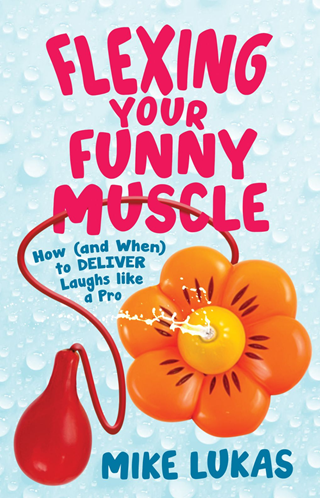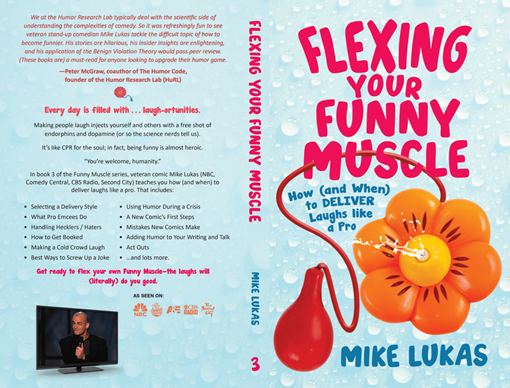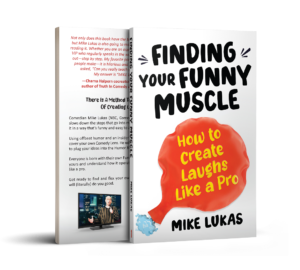“The heart of improvisation is transformation.”
Viola Spolin, American theatre academic, educator and acting coach Tweet
“Comedy equals tragedy plus time.”
- Steve Allen, American Comedian Tweet
Introduction
You’re standing fifth in line at the grocery store with a full cart of food.
There are 10 possible registers but the one you’re waiting on is the only one that’s open.
Tick tock. Tick tock. Your chocolate Haagen-Daz is melting.
Behind you, you hear disgruntled murmuring from the half dozen other cart-pushing customers who are also stuck waiting. Their milk’s getting warm, their frozen peas are getting soggy, and their attitude’s getting frosty.
“Come on, geez.”
“Let’s go.”
“This is bullsh%$.”
You turn and nod.
Suddenly, the store’s PA system crackles on.
“Tammy to the front to open another register. Tammy to the front.”
The PA clicks off, and right then there’s a sudden beat of silence.
Freeze!
That half a beat right there, that’s the moment funny people live for.
It’s in that quick second just after the loudspeaker goes quiet but right before the hum of customer chatter returns that there exists a perfect comic opportunity. Silent tension is in the air just waiting for the perfect unexpected comment to break it.
A funny person immediately recognizes this quick moment.
They’re ready to jump on it because that moment is where some of the biggest laughs can be found.
It’s the ideal time to flex your Funny Muscle to get a big laugh.
Or not.
Naturally funny people spot those moments easily, but for everyone else those opportunities for laughter just flash by unnoticed.
Every day is filled with scores of those . . . laugh-ortunities.
Ahem.
These are tiny pockets of half-seconds where a well-timed quip or comment or punchline or sarcastic question can be inserted for maximum comedic effect.
They happen in public and in private, in groups and one-on-one, in conversation and during group silence, with family, friends and strangers, sober and drunk, day and night.
And the more you start to notice these laugh-ortunities, the quicker you realize how many of them there actually are in your day. It’s like when you suddenly start paying attention to the red cars in traffic or baseball hats in a crowd, and you can’t believe how many you start to spot.
Regarding all this, serious people might ask, “But why bother?”
To which funny people respond, “Because your mother.”
Which means, “To get laughs, fool. To mine for comedy gold.”
For funny people, there are few better feelings than getting a laugh.
We love to crack up our family and friends and strangers and anyone else who’s trapped with us during something annoying or uncomfortable or embarrassing.
Laughs are the rocket fuel that powers our comedy engine.
And making people laugh injects yourself and others with a free shot of endorphins and dopamine (or so the science nerds tell us). You’re handing out a quick fix of euphoric Joy in the middle of tough days as a human.
In fact, being funny is almost heroic; you’re giving folks CPR for their soul.
“You’re welcome, humanity.”
Humor also melts that social ice that can build up and prevent us from fully enjoying each other’s company. Comedians are masters at relieving the tension endured by a “mutually suffering” group. Most of whom might otherwise feel ticked off and isolated and frustrated with uncomfortable situations. The shared laughter that funny people create can uplift and connect those “hurting” people.
It can also go terribly wrong.
That’s because some moments just aren’t funny, and sometimes people aren’t in the mood to laugh. At all.
“Sorry, sir, thought your dramatic heart attack could use a laugh break. My bad. RIP.”
Meanwhile I’m thinking, “My CPR joke KILLED!”
A pro comic (usually) understands the difference between the right time and the wrong time to go for a laugh.
Then we (usually) push it over that line anyway because that’s what makes it even funnier.
Well, at least to us.
Okay, now go back to that grocery store for a second.
Get back to being fifth in that long, single line of impatient customers.
Everyone just heard the same thing.
“Tammy to the front to open up another register. Tammy to the front.”
Followed by that quick beat of silence.
Right there, that could be someone’s chance to steal the moment, to say something funny. To get some well needed laughs from that stuck group.
What would you do?
How would you use your Comedy Lens to flex your Funny Muscle in that moment?
Which Humor Heightening Device(s) would you employ to get a quick laugh?
There are thousands of possibilities.
You could use Negative-to-Positive and Exaggeration and Innuendo and scream, “I love you, Tammy!” or “Marry me, Tammy!”
Or use Extension and Exaggeration with a loud “Tammy for President!”
How about using a Cut Forward To and Recognition by announcing, “Annnnd the mad dash to Tammy’s register starts in 3, 2, 1 . . .”
In that perfect moment, any one of those lines might get a big laugh.
Or they might not.
“Shut up, smart a$$. Nobody’s talking to you.”
“Ba dump bum.”
“Rude!”
Whoops.
Sorry. (Not sorry.)
That’s the thrill and risk of flexing your Funny Muscle in public.
It’s even more daring at a comedy club in front of a crowd of paying strangers.
There you could get thunderous laughter or an even louder batch of awkward silence.
With a few uneasy coughs thrown in.
“Will somebody PLEASE kill that damn cricket in the back of the room!”
Creating laughs is hit or miss.
Knowing when (and when not to) crack wise is part of learning how to become funnier.
Being capable of reading the room and wielding your humor like a scalpel instead of an axe takes a lot of comical (and social) finesse. That means developing an overall understanding of when humor is a welcome distraction and when the jokes are better left unsaid. As well as understanding exactly how you like to deliver your funny material, and what to do if (and when) it doesn’t go well.
Welcome to book three of the Funny Muscle series.
If you’re new to all this, you might want to first check out books one and two of this series.
- Book 1: Finding Your Funny Muscle: How to Create Laughs Like a Pro – here you’ll discover a basic breakdown of all the joke writing concepts I teach including how to discover your Comedy Lens and how to use it with the Humor Blueprint and the 36 Heightening Devices to create original and relatable laughs.
- Book 2: Fine-Tuning Your Funny Muscle: How to Practice Creating Laughs Like a Pro – In this second book I dive deeper into all those Funny Muscle concepts and fine-tune them for you one by one, plus I give you a repeatable game plan to practice being funnier using this blueprint and all those devices with lots of examples.
I suggest you read those two books first, so that way you’ll be familiar with how your Funny Muscle works to create laughs and how to practice doing that. And hopefully you can develop your first five minute set of material that you can use this book to help you deliver.
Your Book 3 Itinerary.
Here in book three, I talk about when humor helps and when it hurts since that will usually become the deciding factor in flexing your Funny Muscle.
Then I go over how to determine your style of comedy delivery. Everyone slings jokes differently – it all depends on how you’re mentally and emotionally and physically wired. You’ll get bigger laughs once you identify and embrace your particular delivery style.
After that, I’ll offer up some insider tips into how to flex your Funny Muscle in different locations, like a pro, including on stage, at work, online, at home, with friends, with strangers, and with lovers.
I’ll also go over a few examples of when it might not be a good idea to flex your Funny Muscle.
Finally, I’ll discuss the best way to deal with getting no laughs or groans as well as how to handle hecklers and haters.
I’m getting the light. Time to wrap up this intro.
Acting guru Viola Spolin famously said, “The heart of improvisation is transformation.”
In other words, within the craft of improv, we say “yes, and” to each new moment and heighten it repeatedly until it morphs into something else that we never saw coming.
Same thing with comedy.
Flex your Funny Muscle for a laugh and a true transformation takes place – we set up frustration or a struggle to transform into something unexpected and silly.
Which usually makes us laugh, transforming our negativity into Joy.
As you know doubt already know humor is a powerful tool that relieves us and connects us right when we need it the most.
Laughter can make our struggles and tragedies almost doable.
It’s a gift to be able to transform a negative moment into a positive one, and that’s exactly what flexing your Funny Muscle can do.
Let’s take a look at how.
Book 3 Available August 9, 2024
Pre-order the Kindle version of Flexing Your Funny Muscle: How (and when) to DELIVER laughs like a pro.
Get your FREE copy of The Business of Comedy!

Includes:
- How Comedians are 5-Tool Players
- How to Attract a Following
- How to Get Bookings
- How to Create Multiple Income Streams
- Manager vs Agent
- And More!









